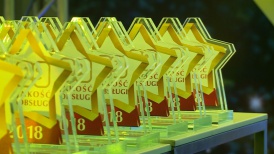| Says: | Matt Harasymczuk |
| Company: | Lunares Habitat |
A possibility of more Poles going to space soon. A space programme to train astronauts is underway.
The Polish space habitat is the first such centre in Europe and a big step forward to sending another Pole in space. As many as five missions have been completed in the Lunares base. All these missions took place in conditions which will also apply to future bases on the Moon or Mars. In addition, scientific experiments are being made and innovative Polish technologies are being tested. This, coupled with a good infrastructure and well-trained staff, can become the beginning of the Polish space programme. In 2030 Poland might join the planned missions to Mars.
“The Lunares Base is an attempt at creating an environment, a so-called habitat, in which we will simulate the behaviour of people in an isolated environment. So far 5 missions have been completed, including educational missions. As part of these we lock up people for two weeks and conduct various scientific research, including into the shift of the circadian rhythm,” Matt Harasymczuk from the Lunares Habitat in Piła, told Newseria Innowacje.
The Lunares Habitat was established to test people in isolation and solitude, living and working in a very confined space. The conditions in the habitat are analogous to those in a future Moon or Mars base. The missions are also an opportunity to conduct experiments and tests which can impact the success of future missions to space, and help colonise the cosmos. The developed space technologies can also find their use on Earth.
Scientists have already tested human endurance when the circadian rhythm is shifted, and their research employing an illusion of time are unique on a global scale. Also, a physiological lamp was created. Thanks to emitting UV waves with a specific frequency, it has a similar effect on the human body as the Sun. In the habitat, there is a special room for hydroponic gardening with centrifuges for the impact of microgravity on biological processes.
As underlined by the expert, the possibilities of the habitat in Piła, coupled with the infrastructure available in Poland, can result in another Pole being soon sent to space.
“This year we celebrate the 40th anniversary of Gen. Hermaszewski’s flight. 40 years is enough time to send another Pole to space. The technologies which are being developed today are an investment. In my opinion, Poland has the infrastructure and is ready to assume the responsibility for training and maintaining an astronaut. We have human centrifuges at the Military Institute of Aviation Medicine and HUET simulators at the diver training centre in Gdynia. There are also other centres, such as our habitat. We also have excellent IT specialists who prepare excellent VR simulations,” Matt Harasymczuk listed.
The Polish Space Strategy prepared by the government entails that by 2030 the national space sector will be able to effectively compete on the European market, and that its turnover will account for at least 3 percent of the total turnover of the space market in the EU. Polish companies are also becoming more and more visible on the market of space innovations. Tests concerning the control of a mobile robot for the European Space Agency are underway. Their results will be used in the Heracles mission, which is a space exploration mission planned for the 2030s. A Polish company is also participating in the NASA InSight mission scheduled for May, whose task is to study the interior of Mars. Also, another Pole will soon go to space.
“In 2026 we will be ready to send another Pole to space. The process of training astronauts is quite long and requires several years of university training and simulations in a neutral buoyancy pool, as well as pilot and habitat simulations. In 2024 the International Space Station will be deorbited. The subsequent steps will be the ESA missions to the Moon and Mars in 2030. In my opinion, Poland could join in and have people ready for that timeline,” Matt Harasymczuk argued.
According to data from Morgan Stanely analytical company, the space market is currently worth 350 bn dollars. In 2040, this will amount to 1.1 bn dollars.
Read also
- 2024-09-17: Opóźnianie wejścia Ukrainy do NATO zwiększy zagrożenie ze strony Rosji dla członków sojuszu. Trwają dyskusje o możliwych warunkach akcesji
- 2024-09-19: Wejście Ukrainy do UE może zająć jeszcze długie lata. Miałoby ono duży wpływ na polskie rolnictwo i rynek pracy
- 2024-09-10: Rośnie ryzyko wzrostu skali bezdomności wśród uchodźców z Ukrainy. W najtrudniejszej sytuacji są osoby z niepełnosprawnościami czy Romowie
- 2024-08-23: Kosmiczne śmieci są coraz większym problemem. Ich obecność na orbicie generuje znaczne koszty
- 2024-08-14: Polskie konsorcjum rozwija innowacyjny system serwisowania i tankowania satelitów na orbicie. To może wydłużyć czas ich eksploatacji o 20 lat
- 2024-07-03: Na rynku kapitałowym brakuje indywidualnych inwestorów. Nowe regulacje UE mają pobudzić ich zaangażowanie
- 2024-06-19: Europa idzie w kierunku ponownego wykorzystywania surowców. Prawo i fundusze unijne będą w kolejnych latach mocno wspierać ten proces
- 2024-06-19: Wysokie temperatury zagrażają zwierzętom domowym. Narażone są na udary cieplne i poparzenia
- 2024-05-14: Podczas wojny w Ukrainie całkowicie zniszczono niemal 10 proc. mieszkań i domów. Proces odbudowy potrzebuje odpowiedniej strategii
- 2023-11-23: Są kolejne dowody na to, że Mars był planetą pełną rzek. Wciąż nie wiadomo jednak, czy istniało na niej życie
Trade

Polish consumers are more satisfied than Americans, with the customer satisfaction level being close to 80 percent
For six years the customer satisfaction index in Poland has grown by over 17 percentage points to nearly 78 percent, and it currently exceeds the customer satisfaction levels recorded in the USA and the United Kingdom. Service quality and its growing significance among businesses have had a tremendous impact on customer satisfaction. For the eleventh time the Customer Service Quality Star titles have been awarded to entrepreneurs recording the best results in this field.
